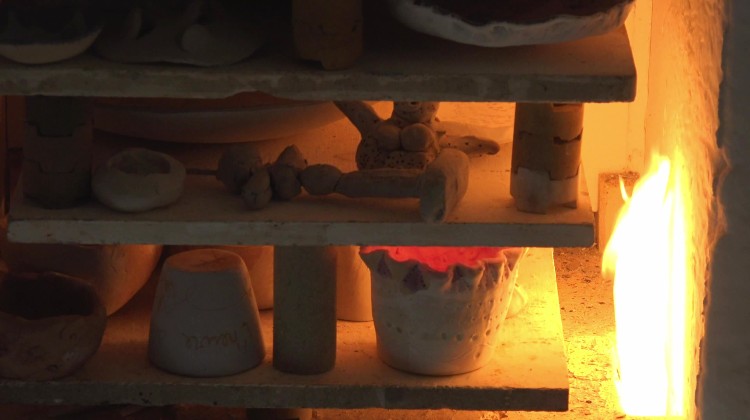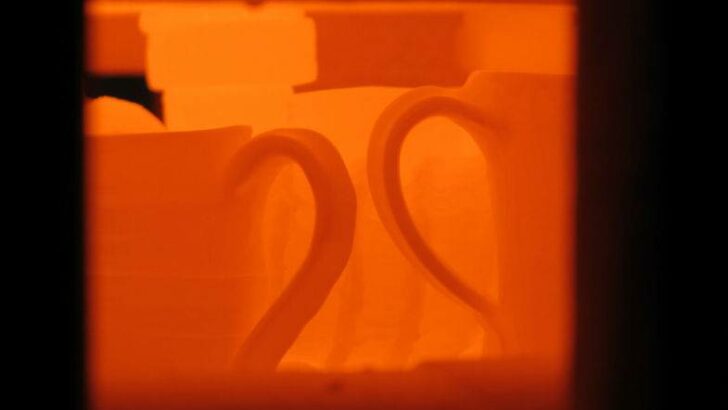Your cart is currently empty!
Lesley
-

8 Reasons Pottery Clay Cracks When Drying & Solutions
Pottery clay cracks when drying if some parts of the piece dry out more quickly than others. When clay dries, it shrinks. If one part of the clay is shrinking faster than the other, this puts an internal strain on the pottery. The clay cracks to cope with the strain.
-

Stack and Slam Wire Wedging | Your Wrists Will Thank You
You may find wedging clay tricky if you have any trouble with your wrists or hands. I have had carpal tunnel in both hands, and I find most wedging techniques cause me trouble. Stack and slam wedging is a godsend and makes wedging easy. Plus, it’s quite enjoyable! Stack and slam wire wedging involves stacking…
-

Oxidation and Reduction in Pottery – Made Simple!
A lot of the articles and books about firing and glazes talk about oxidation and reduction firing. These terms sound scientific and off-putting. Because they are referring to chemical processes, they are complicated. So, I decided to write an account of them that is understandable to all of us ‘non-chemists’. Oxidation occurs when there is…
-

7 Pottery Firing Methods Commonly Used – With Images
The beauty of firing clay is that each method is different from the next. Firing methods range from high-tech digitally controlled and monitored kilns to homemade brick kilns packed with sawdust and leaves. This article will give an easy-to-understand account of 7 of the most common methods of firing clay. The methods covered are electric,…
-

Can You Mix Different Types of Clay? Combining Clay
There are lots of different types of clay and a range of clay bodies to choose from. But, can you mix different types of clay together? Will it create a lovely clay cocktail or a clay catastrophe? Yes, you can mix different types of clay. But, these clays must fire at a similar temperature and…
-

Best Pottery Clay for Beginners | Choosing the Right Clay
Choosing the best pottery clay can feel daunting for beginners. This article has pictures, a video, and a FREE checklist to help you make the best choice.
-

10 Easy Ways to Find a Pottery Firing Service Near Me
When you start out making pottery, chances are you won’t have your kiln. But you probably still want to get your pottery fired. Here are some tips on how to find a pottery firing service near you. How to Find A Pottery Firing Service Nearby The chances are that there is someone on your doorstep…
-

Which Direction Should A Pottery Wheel Turn?
If you are new to using a pottery wheel, you may notice that many of them have a switch that changes the direction that the wheel turns. But which direction should a pottery wheel turn, and does it make a difference? It’s often recommended that right-handed potters have the wheel turning counterclockwise and that left-handed…
-

How to Make Pottery Without Wrist Pain
Wrist pain can sabotage your pottery work. Here are some simple and effective changes to your technique that may help you carry on potting.
-

How to Make a Damp Box For Clay
Life is busy and having somewhere to store half-finished pottery for a week or a few days is handy. You may have heard about a helpful piece of pottery kit called a damp box and wondered what it is. In this article, I will go through what it is and how to make a damp…
-

What Height Should My Potter’s Wheel Be?
My first pottery wheel was a budget wheel with short legs and was quite low to the ground. I was surprised by how much lower it was than the wheels I’d used in class. It got me thinking about what height a potter’s wheel should be. Wheel height is a matter of personal preference, and…

